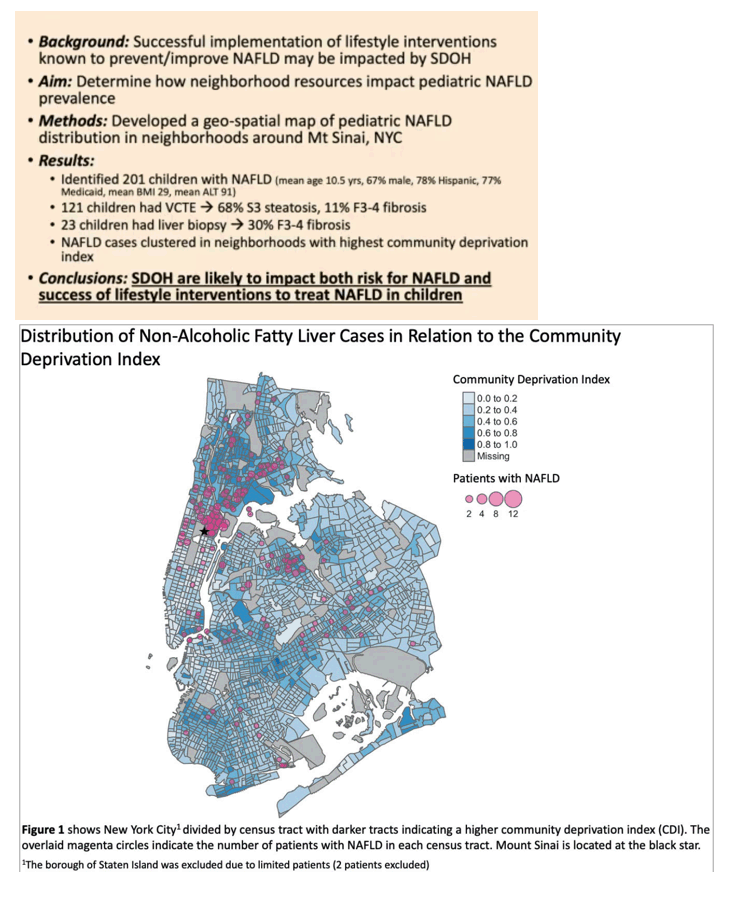 |
 |
 |
| |
PEDIATRIC NON- ALCOHOLIC FATTY LIVER DISEASE: RESIDING IN LOW RESOURCE NEIGHBORHOODS MAY INCREASE RISK
|
| |
| |
AASLD Nov 4-8 2022
Rachel Smith1, Andres Rivera2, Jaime Chu3 and John C. Bucuvalas3, (1)Pediatrics, Icahn School of Medicine at Mount Sinai, (2)Pediatrics, NYC Health and Hospitals at Elmhurst Hospital, (3)Recanati Miller Transplant Institute, Icahn School of Medicine at Mount Sinai
Background: Non-a lcoholic fatty liver disease (NAFLD) is becoming common in pediatrics, leading to increased morbidity from progressive liver disease, cancer, and a need for liver transplantation. Diet and exercise are the primary strategies to prevent, mitigate, and eventually reverse liver fibrosis. The success of these interventions may be heavily influenced by com-munity factors; understanding this relationship could help drive resource- based interventions. We hypothe-size that the prevalence of NAFLD in a large metropol-itan area with significant socioeconomic disparity will be higher in low resource neighborhoods.
Methods: Patients 1- 21 years old within the Mount Sinai Health System from 4/2009- 10/2020 were identified through ICD and IMO codes consistent with NAFLD. Patients were included for chart review if 2 ALT values, sepa-rated by at least 60 days, were greater than age- and gender-a ppropriate norms and the patient resided within New York City limits. Patients were excluded if they had underlying liver disease, history of liver trans-plant, cancer, autoimmune disease, or other systemic illness that can increase liver enzymes. Descriptive statistics were used to assess the patient population. Patients were aggregated at the census tract level and the Community Deprivation Index (CDI) was calculated for each tract. The CDI is a validated tool for assessing neighborhood disparity using US Census Data. Scores range from 0- 1, with 1 indicating the most severe degree of resource deprivation. This was compared against New York City and national data.
Results: Two hundred and one patients were included with ages ranging from 2- 19 years (mean 10.54 years). Sixty- seven percent of the cohort was male, 78% identified as Hispanic, and 76.6% had Medicaid as their primary insurance. Body Mass Index (BMI) at diagnosis ranged from 18.5 to 55.5 (mean 29.4). Mean ALT at diagnosis was 91.7 U/L. On transient elastography, 67.8% had S3 steatosis and 10.7% had F3 or F4 fibrosis out of 121 procedures. On the 23 biopsies performed, 30.4% had stage 3 or 4 fibrosis. NAFLD cohort mean CDI was 0.50 compared to 0.39 in New York City and 0.35 nationally. Figure 1 highlights the clustering of NAFLD cases in areas with high CDI.
Conclusion: While the study design limits the capacity to assign causality, children with NAFLD are co-located with increased neighborhood deprivation. Deeper investigation will confirm and expand our understanding, perhaps pointing towards population- based strategies to mitigate this emerging risk.

|
| |
|
 |
 |
|
|